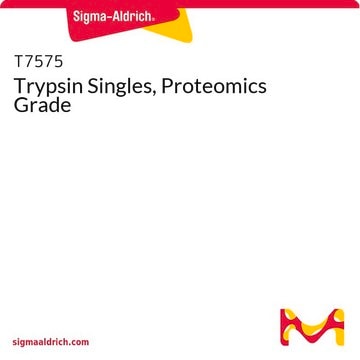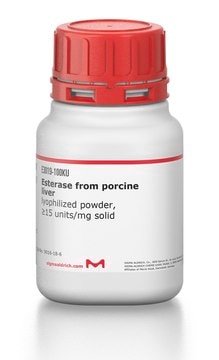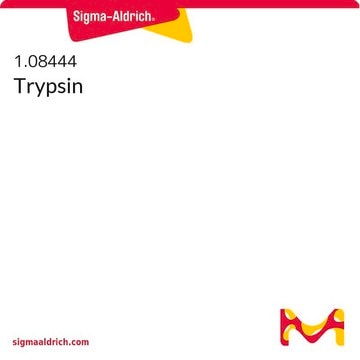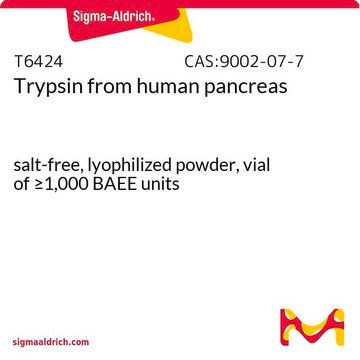This product is soluble in 1mM HCL.
T6567
Trypsin from porcine pancreas
Proteomics Grade, BioReagent, Dimethylated
Synonym(s):
Porcine Trypsin, Trypsin for Mass Spectropetry
Select a Size
Select a Size
About This Item
Recommended Products
biological source
Porcine pancreas
Quality Level
product line
BioReagent
solubility
1 mM HCl: soluble 1 mg/mL, clear, colorless
shipped in
wet ice
storage temp.
2-8°C
General description
Application
Biochem/physiol Actions
related product
Signal Word
Danger
Hazard Statements
Precautionary Statements
Hazard Classifications
Eye Irrit. 2 - Resp. Sens. 1 - Skin Irrit. 2 - STOT SE 3
Target Organs
Respiratory system
Storage Class Code
11 - Combustible Solids
WGK
WGK 1
Personal Protective Equipment
Regulatory Listings
Regulatory Listings are mainly provided for chemical products. Only limited information can be provided here for non-chemical products. No entry means none of the components are listed. It is the user’s obligation to ensure the safe and legal use of the product.
ISHL Indicated Name
Substances Subject to be Indicated Names
ISHL Notified Names
Substances Subject to be Notified Names
JAN Code
T6567-5X20UG-KC:
T6567-BULK:
T6567-5VL:
T6567PROC:
T6567-1VL:
T6567-20UG:
T6567-1MG:
T6567-5X20UG:
T6567-20UG-KC:
T6567-VAR:
Choose from one of the most recent versions:
Certificates of Analysis (COA)
Don't see the Right Version?
If you require a particular version, you can look up a specific certificate by the Lot or Batch number.
Already Own This Product?
Find documentation for the products that you have recently purchased in the Document Library.
Customers Also Viewed
Articles
Evaluation of Recombinant, Chemically Treated Trypsin in Proteomics and Protein Characterization Assays
Get better detection and quantification of proteases with this high-sensitivity red protease detection assay.
Pretreatment with Mucinase StcE increases glycopeptide identification from mucin samples, enhancing sample preparation efficiency for glycopeptide analysis.
The field of proteomics is continually looking for new ways to investigate protein dynamics within complex biological samples. Recently, many researchers have begun to use RNA interference (RNAi) as a method of manipulating protein levels within their samples, but the ability to accurately determine these protein amounts remains a challenge. Fortunately, over the past decade, the field of proteomics has witnessed significant advances in the area of mass spectrometry. These advances, both in instrumentation and methodology, are providing researchers with sensitive assays for both identification and quantification of proteins within complex samples. This discussion will highlight some of these methodologies, namely the use of Multiple Reaction Monitoring (MRM) and Protein-AQUA.
Protocols
Continuous spectrophotometric rate determination method using BAEE substrate measures trypsin activity, essential for enzyme characterization.
-
What can I use to solubilize this Product T6567, Trypsin from porcine pancreas?
1 answer-
Helpful?
-
-
How can we digest protein using Product T6567, Trypsin from porcine pancreas?
1 answer-
As per Sigma R and D the information is as follows: In order to efficiently digest a protein with trypsin, it must be denatured and the disulfide bonds modified by reduction and alkylation, or at least reduced. Many intact proteins are highly resistant to digestion with trypsin. If you do not want to reduce and alkylate, you can then just boil the protein with 5 mM DTT or 20 mM 2ME for 10 minutes, and then quickly cool on ice to denature the protein. This may result in a precipitate, but the trypsin will still digest the protein and it will clear within an hour or two. You can also dissolve the protein in 6 M guanidine-HCl or 8 M urea. Reduce and alkylate using the PROT-RA kit or other suitable method. Then they would have to dilute the solution to less than 2 M of either denaturant and then add the trypsin. This is the method that we use routinely in the lab.
Helpful?
-
-
What is the Department of Transportation shipping information for this product?
1 answer-
Transportation information can be found in Section 14 of the product's (M)SDS.To access the shipping information for this material, use the link on the product detail page for the product.
Helpful?
-
-
Is Product T6567, Trypsin from porcine pancreas, TPCK treated?
1 answer-
The product has been treated with TPCK to remove chymotryptic activity, further purified through affinity chromatography, and lyophilized, resulting in convenient use and highly specific cleavage. This information is on the product page under application.
Helpful?
-
-
What is the package size of Product T6567, Trypsin from porcine pancreas?
1 answer-
Each vial content 20 ug of the product.
Helpful?
-
-
How can we get Trypsin sequence information for Product T6567, Trypsin from porcine pancreas?
1 answer-
If you are looking for trypsin sequence information, you have to go to the NCBI Protein Data Bank.
Helpful?
-
Active Filters
Our team of scientists has experience in all areas of research including Life Science, Material Science, Chemical Synthesis, Chromatography, Analytical and many others.
Contact Technical Service













